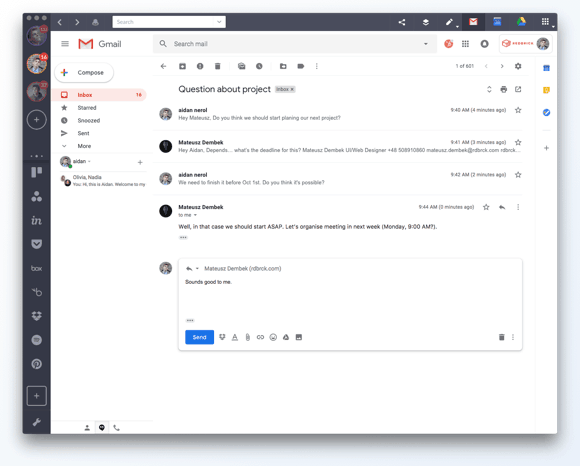Writing great follow-up emails is an imprecise art.
Sure, you could simply reiterate what you’ve already mentioned in your first email, add a couple of bold words and exclamation points throughout, and sign off with the all-too-classic, “Hope to hear from you soon!”
Or, you could learn the art of writing exceptional follow-up emails—you know, the ones that encourage openings, capture attention and invoke action from readers.
Believe it or not, writing great follow-up emails could be the difference between lackluster campaign performance and high response and engagement rates.
Leaning on some of the best advice from across the web, we’ve compiled eight tips that cover how to write great follow-up emails and get the conversation rolling with recipients.
We’ve broken these tips down into what we consider to be four of the most important aspects of a follow-up email: subject line, body, tone, and structure.
SPOILER: None of these tips require you to use what has been deemed the most unattractive phrase in the email-verse: “just checking in.”
*shutter*
Writing Great Follow-Up Emails: Subject Line
A quick Google search for how to craft the perfect follow-up email subject line, and you’ll find yourself staring back at millions of tips. Millions.
But, as they say, all advice isn’t good advice.
So, to save you the trouble of countless hours of tip-reviewing, we took the time to review quite a bit of the advice floating around and filtered out a couple of tips that really work.
Use the recipient’s name (if it makes sense): This tip was borrowed from LeadFuze. According to the lead gen company, using the recipient’s name (or company name, if the personal name isn’t known) makes the follow-up email more personal, thereby increasing the chances that it will get opened.
Mention a skill, interest or trait: This is another ‘make it personal’ tip that we found on HubSpot. As with all good copy, the goal is to make the content about the person it is written for…not about your service or product. For instance, saying something like, “So, you speak French?” is guaranteed to take the recipient’s interest to another level. Although this approach may not be perfectly aligned with the purpose of your campaign, it makes for an inviting subject line that is sure to get clicked.
Writing Great Follow-Up Emails: Body
Our experience with email tells us that writing the perfect body content is a daily struggle for many Shift users.
How long should the body of your follow-up email be? What all should you say, or re-say?
So many questions. Well, we have a couple of answers that should set you straight in your goal of crafting the perfect body content for your follow-up emails.
Establish relevancy immediately: According to Kajabi, a knowledge commerce platform for internet and marketing experts, relevancy should be the first thing established within the body of your email. In other words, the message that needs to be conveyed in your email should be in the very first sentence. From there, it can be reiterated, but the first line of the email’s body should sum up exactly what the follow-up email is about.
Don’t repeat yourself: In an article about how to write high-performing emails from Nutshell, it was suggested that follow-up emails be free of duplicate content. Instead, you should be using the body content in your follow-up email for things like providing additional details that weren’t included in the initial email, articulating your product or service’s ROI and value proposition, and inviting the recipient to ask any questions he or she may have.
Writing Great Follow-Up Emails: Tone
Did you know that the tone of your email sometimes plays into a recipient’s decision to either act or ignore?
Well, it does.
That said, here’s a couple of things you should consider for improving the tone of your follow-up emails.
Use emojis: Say what?! ? That’s right! This tip, one of our very own, stems from the fact that we are now living in a time where emojis plays an integral role in the way we communicate and convey our messages. As a result, they are unmatched in their ability to visually express the tone of one’s message or content. Want to show excitement? Use one of the many yellow smiley faces. Need to show how much your product or service means to your customers? Add a heart emoji.
Using a couple of emojis in your follow-up email could help make the content of your email more relatable, thereby motivating your recipients to take action, among other things.
You can find some quick tips on emoji etiquette and using these fun picture characters in professional messages in our emoji article from January 2018.
Avoid imperatives: A 2017 article from Fast Company indicates that using imperatives, or commands (e.g., “Do this,” “Think about that,” “Try this”), will give your content a demanding tone. And in case you don’t already know, people don’t like being told what to do. What should be used in place of imperatives are questions and suggestions, like “You should do this” and “What do you think about this?”
Not only will this lighten the tone, it’ll help readers make a stronger connection with your follow-up email content.
Writing Great Follow-Up Emails: Structure
Because there are few things more pleasing than a well-structured email, right?
Right. The last thing you want to do is confuse your readers with unstructured email content. Or, by writing a bunch of content and using no visuals. Ugh.
The structure of your follow-up email is its visual appeal. Your goal is to get it right the first time.
Space out your text: There are few [email] evils worse than chunky, never-ending blocks of text. Our advice is to keep your paragraphs short and your sentences shorter. With that, be sure to add space between your text. We wouldn’t suggest writing more than three sentences before adding a space. Use short, straight-to-the-point wording: Like this.

Another suggestion is to refrain from repeating yourself over and over and avoid taking forever to get to your point (recall the first tip from “Body”).
Make it easy to respond: In a Medium article from ClosingPage, the company talks about the need to ensure your email recipients have easy access to whatever action you’re wanting them to take. For example, if the goal is to get recipients to schedule a call with you, structure your email to include your Calendly or Google Calendar link. Want them to weigh in on a topic? Structure your email to include a Typeform survey.
Finally, in addition to any and all other advice, be sure to make every effort to include some sort of relevant visual.
In Closing…
The inbox is a very crowded space.
That said, your recipients will likely have little to no patience for boring, general, sales-focused follow-up emails from you.
For this reason, it’s important to get it right the first time with your follow-up efforts.
And don’t worry about becoming overwhelmed with all the pieces that go into managing your follow-up campaign. Shift Pro accounts integrate with several of your most useful apps and extensions, like Boomerang and Collabspot.
Keep the conversations flowing and the open rates high with these field-tested follow-up email tips.
Ten articles before and after
Top Spotify Playlists for Getting Work Done
How to Send an Event Invitation Through Gmail
The Art of the Out-of-Office Reply (Setup and Removal)
Archive Vs. Delete: What To Do After Reading an Email
How to Create an Asana Task from Email
Listen Up, Inbox By Gmail Users: Here's What You Need To Know
How To Create Gmail Filters for Your Accounts
How To Start A Google Hangouts Video Call Inside Gmail
How To Sync Multiple Gmail Calendars (For Viewing & Editing)
